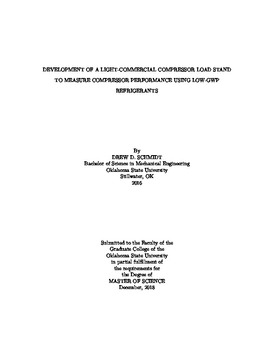| dc.contributor.advisor | Bradshaw, Craig R. | |
| dc.contributor.author | Schmidt, Drew D. | |
| dc.date.accessioned | 2019-07-19T14:49:24Z | |
| dc.date.available | 2019-07-19T14:49:24Z | |
| dc.date.issued | 2018-12-01 | |
| dc.identifier.uri | https://hdl.handle.net/11244/320998 | |
| dc.description.abstract | Popular hydrofluorocarbon refrigerants such as R134a and R410A are in the process of being phased out due to the high Global Warming Potential (GWP) of these fluids. A large variety of low-GWP refrigerants are being considered as replacements including R1234yf, R1234ze(E), R1234ze(D), R32, and blends of these with traditional refrigerants. As a result of high efficiency standards for HVAC&R equipment, the choice of refrigerant has a large impact on the design of a compressor to maximize its efficiency. Therefore, changing the most common refrigerants will require significant design changes to compressors and test environments that support re-design activities such as a hot-gas bypass compressor load stand. The hot-gas bypass style is a common system design to test compressors and is used for its many benefits, including rapid transition between testing conditions and low operational cost. A thermodynamic model of a hot-gas bypass cycle has been developed in Engineering Equation Solver (EES). Outputs from this model were used to select the components and tubing sizes in combination with ASHRAE guidelines. The design capacity for the load stand is a range of 10-80 tons (35-281 kW) compressor capacity. The large range in capacities desired created many design challenges to overcome including maintaining proper oil circulation and refrigerant velocity. The compressor load stand is capable of testing the performance of different compressors over a range of operating conditions. It also includes independent control over oil circulation/injection rate as well as a dedicated economizer circuit. These capabilities can then be used to optimize a wide spectrum of compressor types on low-GWP refrigerants. Ultimately, the load stand serves as a new addition to the thermal systems research infrastructure at Oklahoma State University. This allows for the continuation of research into new compressor technologies, as well as, for improvements in compressor efficiency in existing technologies. | |
| dc.format | application/pdf | |
| dc.language | en_US | |
| dc.rights | Copyright is held by the author who has granted the Oklahoma State University Library the non-exclusive right to share this material in its institutional repository. Contact Digital Library Services at lib-dls@okstate.edu or 405-744-9161 for the permission policy on the use, reproduction or distribution of this material. | |
| dc.title | Development of a Light-Commercial Compressor Load Stand to Measure Compressor Performance Using Low-GWP Refrigerants | |
| dc.contributor.committeeMember | Bach, Christian | |
| dc.contributor.committeeMember | Spitler, Jeffrey D. | |
| osu.filename | Schmidt_okstate_0664M_16046.pdf | |
| osu.accesstype | Open Access | |
| dc.description.department | Mechanical and Aerospace Engineering | |
| dc.type.genre | Thesis | |
| dc.type.material | Text | |
